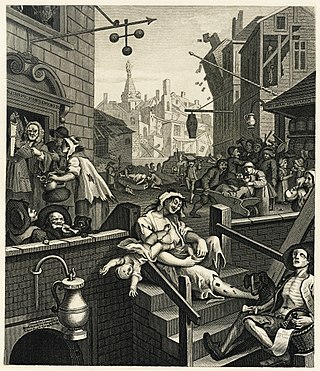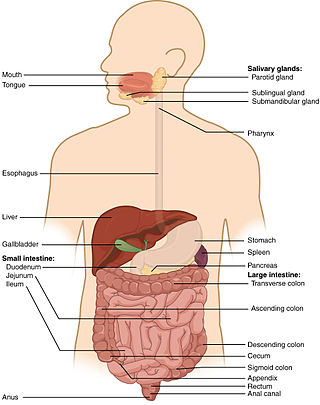Related Research Articles

Alcohol intoxication, commonly described in higher doses as drunkenness or inebriation, and known in overdose as alcohol poisoning, is the behavior and physical effects caused by recent consumption of alcohol. The technical term intoxication in common speech may suggest that a large amount of alcohol has been consumed, leading to accompanying physical symptoms and deleterious health effects. Mild intoxication is mostly referred to by slang terms such as tipsy or buzzed. In addition to the toxicity of ethanol, the main psychoactive component of alcoholic beverages, other physiological symptoms may arise from the activity of acetaldehyde, a metabolite of alcohol. These effects may not arise until hours after ingestion and may contribute to a condition colloquially known as a hangover.

An enema, also known as a clyster, is an injection of fluid into the rectum or into lower bowel by way of the rectum. The word enema can also refer to the liquid injected, as well as to a device for administering such an injection.

Glycerol is a simple triol compound. It is a colorless, odorless, viscous liquid that is sweet-tasting and non-toxic. The glycerol backbone is found in lipids known as glycerides. It is also widely used as a sweetener in the food industry and as a humectant in pharmaceutical formulations. Because of its three hydroxyl groups, glycerol is miscible with water and is hygroscopic in nature.

Rectal foreign bodies are large foreign items found in the rectum that can be assumed to have been inserted through the anus, rather than reaching the rectum via the mouth and gastrointestinal tract. It can be of clinical relevance if the patient cannot remove it the way they intended. Smaller, ingested foreign bodies, such as bones eaten with food, can sometimes be found stuck in the rectum upon X-ray and are rarely of clinical relevance.
Alcohol inhalation is a method of administering alcohol directly into the respiratory system, with aid of a vaporizing or nebulizing device or bag. It is chiefly applied for recreational use, when it is also referred to as alcohol smoking, but it has medical applications for testing on laboratory rats, and treatment of pulmonary edema and viral pneumonia. Depending on precise definition of alcohol, botanical alcohol inhalation can be a subgenre of aromatherapy.

Gastrointestinal diseases refer to diseases involving the gastrointestinal tract, namely the esophagus, stomach, small intestine, large intestine and rectum; and the accessory organs of digestion, the liver, gallbladder, and pancreas.

A beer bong is a device composed of a funnel attached to a tube used to facilitate the rapid consumption of beer. The use of a beer bong is also known as funneling.

A breathalyzer or breathalyser, also called an alcohol meter, is a device for measuring breath alcohol content (BrAC). It is commonly utilized by law enforcement officers whenever they initiate traffic stops. The name is a genericized trademark of the Breathalyzer brand name of instruments developed by inventor Patrick Tegeler in the 1950s.

Fomepizole, also known as 4-methylpyrazole, is a medication used to treat methanol and ethylene glycol poisoning. It may be used alone or together with hemodialysis. It is given by injection into a vein.

Alcohol tolerance refers to the bodily responses to the functional effects of ethanol. This includes direct tolerance, speed of recovery from insobriety and resistance to the development of alcohol use disorder.
Alcohol has a number of effects on health. Short-term effects of alcohol consumption include intoxication and dehydration. Long-term effects of alcohol include changes in the metabolism of the liver and brain, with increased risk of several types of cancer and alcohol use disorder. Alcohol intoxication affects the brain, causing slurred speech, clumsiness, and delayed reflexes. There is an increased risk of developing an alcohol use disorder for teenagers while their brain is still developing. Adolescents who drink have a higher probability of injury including death.

An anal plug is a medical device that is often used to treat fecal incontinence, the accidental passing of bowel moments, by physically blocking involuntary loss of fecal material. Fecal material such as feces are solid remains of food that does not get digested in the small intestines; rather, it is broken down by bacteria in the large intestine. Anal plugs vary in design and composition, but they are typically single-use, intra-anal, disposable devices made out of soft materials to contain fecal material and prevent it from leaking out of the rectum. The idea of an anal insert for fecal incontinence was first evaluated in a study of 10 participants with three different designs of anal inserts.

A hangover is the experience of various unpleasant physiological and psychological effects usually following the consumption of alcohol, such as wine, beer, and liquor. Hangovers can last for several hours or for more than 24 hours. Typical symptoms of a hangover may include headache, drowsiness, concentration problems, dry mouth, dizziness, fatigue, gastrointestinal distress, absence of hunger, light sensitivity, depression, sweating, hyper-excitability, irritability, and anxiety.

Drinks containing alcohol are typically divided into three classes—beers, wines, and spirits—with alcohol content typically between 3% and 50%. Drinks with less than 0.5% are sometimes considered non-alcoholic.

Rectal administration uses the rectum as a route of administration for medication and other fluids, which are absorbed by the rectum's blood vessels, and flow into the body's circulatory system, which distributes the drug to the body's organs and bodily systems.
Vodka eyeballing is the practice of consuming vodka by pouring it into the eye sockets, where it is absorbed through the mucous membranes of the region into the bloodstream. Reports of this practice as a new fad surfaced in the media beginning in 2010, as hundreds of clips of persons purporting to engage in the practice were posted on YouTube. The practice is promoted by advocates as causing rapid intoxication, but the amount of alcohol absorbed by the eye is low.

Auto-brewery syndrome (ABS) is a condition characterized by the fermentation of ingested carbohydrates in the gastrointestinal tract of the body caused by bacteria or fungi. ABS is a rare medical condition in which intoxicating quantities of ethanol are produced through endogenous fermentation within the digestive system. The organisms responsible for ABS include various yeasts and bacteria, including Saccharomyces cerevisiae, S. boulardii, Candida albicans, C. tropicalis, C. krusei, C. glabrata, C. parapsilosis, Kluyveromyces marxianus, Klebsiella pneumoniae, and Enterococcus faecium. These organisms use lactic acid fermentation or mixed acid fermentation pathways to produce an ethanol end product. The ethanol generated from these pathways is absorbed in the small intestine, causing an increase in blood alcohol concentrations that produce the effects of intoxication without the consumption of alcohol.
The Macy Catheter is a specialized catheter designed to provide comfortable and discreet administration of ongoing medications via the rectal route. The catheter was developed to make rectal access more practical and provide a way to deliver and retain liquid formulations in the distal rectum so that health practitioners can leverage the established benefits of rectal administration. Patients often need medication when the oral route is compromised, and the Macy Catheter provides an alternative for those medications that can be prescribed per rectum. The Macy Catheter is of particular relevance during the end of life, when it can help patients to remain comfortable in their home.

Alcohol, sometimes referred to by the chemical name ethanol, is the second most consumed psychoactive drug globally behind caffeine. Alcohol is a central nervous system (CNS) depressant, decreasing electrical activity of neurons in the brain. The World Health Organization (WHO) classifies alcohol as a toxic, psychoactive, dependence-producing, and carcinogenic substance.
This page is a list of terms related to the psychoactive drug alcohol.
References
- ↑ "Teens using vodka tampons to get drunk". KPHO-TV. 7 November 2011.
- ↑ Lovett, Edward; McNiff, Eamon (2012-09-21). "5 Shocking Ways Your Kids Try to Get Drunk". ABC News. Retrieved 2019-12-23.
- 1 2 Thomas Peterson; Landen Rentmeester; Bryan S. Judge; Stephen D. Cohle & Jeffrey S. Jones (11 November 2014). "Case Report – Self-Administered Ethanol Enema Causing Accidental Death". Case Reports in Emergency Medicine. 2014. Hindawi Publishing Corporation: 191237. doi: 10.1155/2014/191237 . PMC 4243473 . PMID 25436159.
- ↑ "Experts: Alcohol enemas 'extremely dangerous'". CNN. 26 September 2012.
- ↑ Carod-Artal, F.J. (2015). "Hallucinogenic drugs in pre-Columbian Mesoamerican cultures". Neurología (English Edition). 30 (1): 42–49. doi: 10.1016/j.nrleng.2011.07.010 . PMID 21893367.
- ↑ "Woman accused of giving husband lethal sherry enema". Houston Chronicle. 2 February 2005.
- ↑ "Charges dropped in sherry-enema death". Houston Chronicle. 4 October 2007.
- ↑ "Charges dismissed in Texas sherry enema death". Reuters. 3 October 2007.